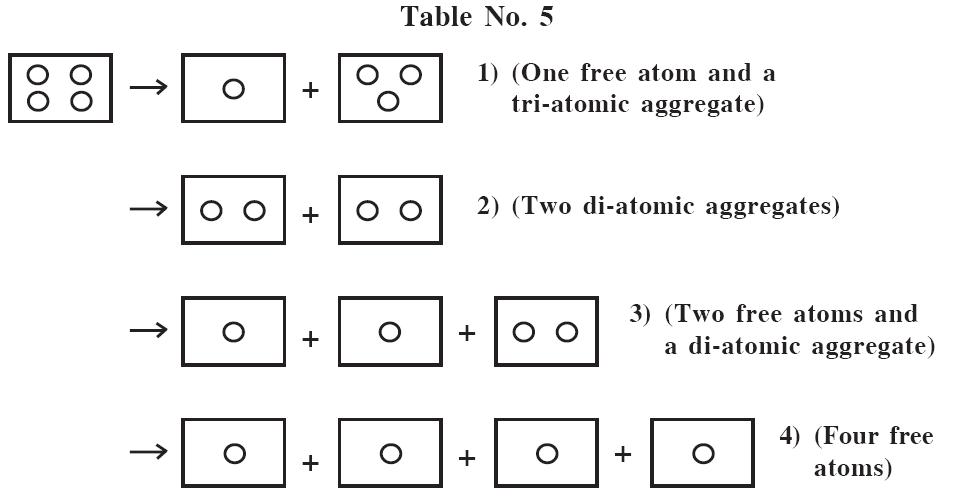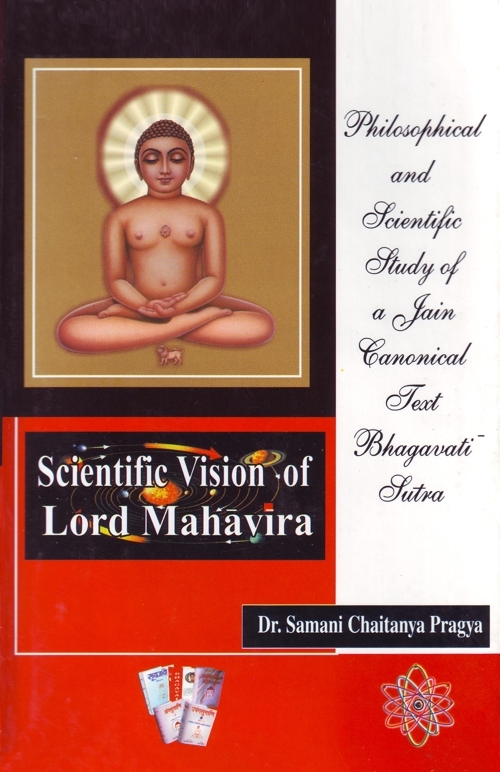Perceptibility
Pudgala is sense-perceptible. According to the Jain canonical literature, every Pudgala or physical object does posses colour, taste, smell and touch. As said already Pudgala alone is the substance that can be the object of sensory knowledge.
Each of the qualities is capable of stimulating specific sensory equipment of an animate organism. The stimuli are then conveyed by the respective sense organs to the cognizing apparatus, enabling it to perceive the physical object. Thus, whatever is perceived or is perceivable must necessarily belong to the physical order of existence.[47] Conversely, whatever is bereft of sensory qualities is non-physical.[48]
The other five substances (the medium of motion, the medium of rest, space, soul and time) are devoid of the material qualities and are, therefore, incapable of being the object of sense-cognition. That is how, matter alone is 'rupi' while the others are 'arupi'.[49] The term 'rupi' does not mean visible but perceivable and signifies the concurrent existence of all the four sense data. The physical order of existence is one that can be perceived by means of sense organs. The physical order does not depend for its existence upon the fact of actually being perceived. Thus, the Jain philosophical views broadly agree with the modern science in so far as the general definition of the physical existence is concerned.
One thing remarkable in this perspective is that perceptibility does not depend on the number of atoms in the cluster but on a special combination of atoms involving the joint process of integration and disintegration. According to the commentary on Tattvarth, neither disintegration nor integration alone can produce perceptibility.[50]
The problem, as N. M. Tatia indicates, of perceptibility of matter is essentially connected with the integration of atoms which is a difficult issue.[51] An atom has no parts. How can two atoms, both of which are without parts, combine together to make a single cluster? How can many imperceptible units create a perceptible one? The commentory[52] discusses this problem at length and attempts to solve the issue by distinguishing two aspects of atom: an atom as partless matter and an atom as the integrated qualities of touch, taste, smell and colour. These two aspects are respectively called "matter-atom" and "quality-atom".[53] The integration of the qualities of touch, taste and so on, to a point of saturation, may result in perceptibility.
Fissionable and Fusionable
As pointed out, the very name 'Pudgala' is derived from its virtue of being fusionable and fissionable. Matter's extent is sometimes increased on account of the combination of its parts and is sometimes decreased as a result of their dissociation.
The process of fusion is called bandha i.e. integration. The process of fission is called bheda i.e. disintegration. The infinite variety of the physical universe and tremendous energy of Pudgala come into existence is due to its fissionable and fusionable properties.[54]
The process of fusion, as indicated before, results in the formation of physical objects. The number of atom combining together in a fusion process may range from two to infinite. The objects formed by fusion of atoms are called skandhas i.e. aggregates or composite bodies. Two or more aggregates may also unite to form one larger object. Sometimes only a few atoms may unite with an aggregate.[55]
In the process of fission, the aggregates of atoms break up to form various other combinations. These newly formed combinations may be smaller or bigger aggregates relatively to one another. Sometimes even a single atom may form a complete whole.[56] An aggregate composed of four primary atoms may break up in the following four ways:

Laws of Fusion
Out of the four innate qualities, viz. touch, taste, smell and colour, only the first one i.e. touch is responsible for the process of fusion.[57]
The Jain Acharyas by their profound knowledge of the structure of Pudgala have established that the process of fusion of atoms and production of aggregates follow some definite rules which have been mentioned in the scripture like Paṇṇavanā,[58] Gommaṭasāra[59] etc. The later works also discuss these rules in detail.[60]
All forms of matter including atoms possess the quality of viscosity (negative charge) or dryness (positive charge) which vary in their degrees of intensity, such as, one-degree to numerable, innumerable and infinitedegrees. In fact, these two tactile qualities are only responsible for the integration of atoms. Though different views are found in Jainism regarding the problem of combination yet, one thing that is unanimously accepted is that there cannot be integration of atoms that possess only one degree of viscosity or dryness. According to the commentaries of Tattvartha, the implications of this condition are that atoms of two or more degrees can integrate with each other whether both of them are of the same quality or different qualities.[61]
The commentary of Tattvārtha also points out that one-degree atom can integrate with a two-degree atom of different quality. However, this is rejected categorically in Sarvārthasiddhi. Accordingly, one-degree atoms cannot integrate under any conditions.[62] Further, the Sabhāṣyatattvārthā- digama, a commentary on Tattvārth, illustrates this law by making some difference between the integration of the same quality and that of the different qualities. It presents the example of two wrestlers of equal strength in which neither will win. So two equally viscous atoms or equally dry atoms cannot integrate with each other. However, the Digambar tradition interprets the law to mean that there cannot be integration of atoms of the same degree even if one is dry and one viscous.
Moreover, two atoms of similar quality cannot integrate if there is only difference of one-degree between them. This is not the condition for the atoms of different qualities. It means if there is a two-degree viscous atom on one side and a three-degree dry atom on the other, they can combine together.
However, according to the Digambar tradition,[63] integration only occurs between atoms, whether similar or different in quality, if their intensities differ by exactly two degrees e.g. a two-degree viscous atom can integrate with a four-degree atom, either viscous or dry.
One thing to be noted, here, is that in integration, the atom with equal or higher degree of viscosity or dryness transforms the intensity of the dissimilar atom to its own though it is not possible to predict which will transform the other. So far as similar atoms are concerned a higher degree raises a lower degree to its own level.[64] Here also the Digambar tradition[65] differs. Thus, in integration, the atom with greater degree of intensity transforms into the atom that is two degrees less to be like it.
In toto, clusters of matter are produced in three ways: by integration, disintegration and by a combination of integration and disintegration (see Table-4). While an atom is always produced by disintegration.[66]
The following tables show the permissible or otherwise combination of atoms with that of different degrees of dryness and viscosity.
| Table No. 6 | ||
|---|---|---|
| Atomic Integration According to Shvetambar Tradition | ||
| Degrees of Intensity | Same Quality | Different Quality |
| One + one | No | No |
| One + two | No | No |
| One + three | No | No |
| One + four or more | No | No |
| Two or more + equal number | No | Yes |
| Two or more + one degree higher | No | Yes |
| Two or more + two degrees higher | Yes | Yes |
| Two or more + three or more degrees higher | Yes | Yes |
| Table No. 7 | ||
|---|---|---|
| Atomic Integration According to Digambar Tradition | ||
| Degrees of Intensity | Same Quality | Different Quality |
| One + one | No | No |
| One + two | No | No |
| One + three | No | No |
| One + three or more | No | No |
| Two or more + equal number | No | No |
| Two or more + one degree higher | No | No |
| Two or more + two degrees higher | Yes | Yes |
| Two or more + three or more degrees higher | No | No |
Finally, according to the Bh.S;[67] the process of fusion can be classified from various standpoints as under:
Fusion is two-fold:
(a) Natural and (b) produced by effort
From another point of view it is two-fold,[68]
(a) Partial union and (b) total union
Natural fusion is again of two types—(i) with beginning and (ii) without beginning. There are three causes for the former.[69]
- Fusion caused by bandha pratyayika i.e. the viscous and dry properties of the constituents.
- Fusion caused by the bhajana pratyayika i.e. contents of a common container.
- Fusion caused by Parinama pratyayika i.e. maturation.
The material atoms and their clusters are numerically infinite. Hence, substantially, Pudgala is stated to be infinite.[70]
The maximum extension of Pudgala is universe (cosmos).[71] Pudgala, fills the cosmos and pervades its total space. In other words, infinite atoms exist, independently or in combinations, in cosmic space only. There is not a single point in space where there is neither an ultimate atom nor a composite body.[72] The whole space is occupied by pudgala. Nature abhors a vacuum.
Another thing worth noticing is that the non-absolutist Jain thinker does not find any contradiction in the basic unity and the infinite multiplicity of an existent. In this case, the reality of infinite diversity of the physical existence does not contradict its inherent unity since, it is composed of ultimate atoms. Atom is the indestructible physical reality[73] and in this respect there is only one or single class of Pudgala.
(ii) Tattvā. Sū.; 5/26—saṁghāta-bhedebhya utpadyante.
(iii) Tattvā. Sū.; 5/27—bhedad anuḥ.
 Dr. Samani Chaitanya Pragya
Dr. Samani Chaitanya Pragya

